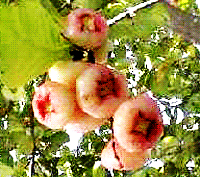FRUIT ORIGINAL INDONESIA
Guava Fruit Water
 Guava water comes from the Indo China and Indonesia, spread to Malaysia and the islands of the Pacific. All this is concentrated as garden plants for home consumption. Guava fruit is not only sweet water refreshing, but has the diversity in appearance. Guava Fruit Water (Eugenia aqua Burma) considered one of the fruits of potential that has not been touched its cultivation for commercial purposes.
Guava water comes from the Indo China and Indonesia, spread to Malaysia and the islands of the Pacific. All this is concentrated as garden plants for home consumption. Guava fruit is not only sweet water refreshing, but has the diversity in appearance. Guava Fruit Water (Eugenia aqua Burma) considered one of the fruits of potential that has not been touched its cultivation for commercial purposes.
It’s easy to foul a critical issue that needs to be solved. The fruit can be said to be skinned, so little physical damaged fruit will hasten the rotting fruit.
In addition, there are 2 types of guava is widely planted, but they are not so conspicuous difference. The two types are Syzygies quaeum (small water guava) and Syzygium samarangense (large water guava). Large guava varieties namely: guava Semarang, Madura, Candles (super sweet), Apples and Cincalo (red and green / white) and guava types are: Camplong (Bangkalan), Buttons, Rose (pink palace), Sukaluyu , Baron, Shocked, Rojak, Neem, Bell (super heavy), and Manalagi (without seeds). While most commercial varieties are Cincalo and Semarang, each of which consists of 2 types (red and white).
FRUIT ORIGINAL INDONESIA
In general, water guava eaten fresh, but can also be made puree, syrup, jelly, jam / preserves the form of the other. Aside from being "a table" water guava also has a sophisticated fine dining with made salads and fruit cocktail. Important chemical content of the guava is sugar and vitamin C. Fruit ripe guava sweet, besides also served as table fruit for salad and pickles. Sometimes the bark can be used as medicine.
According to statistics from the Office of Food Crops, West Java, Khanewal district, Tangerang, Bogor, Sukabumi, Cianjur, Bandung, Garut, Cirebon, Subang and Bekasi including 10 major centers guava tree planting. Cincalo red guava is widely available in Karachi and is famous for its guava Bolang which when ripe scarlet blue with sweet-sour taste of fresh water while Jambu Semarang (red and white) are common in Indramayu.
Guava Fruit Water
 Guava water comes from the Indo China and Indonesia, spread to Malaysia and the islands of the Pacific. All this is concentrated as garden plants for home consumption. Guava fruit is not only sweet water refreshing, but has the diversity in appearance. Guava Fruit Water (Eugenia aqua Burma) considered one of the fruits of potential that has not been touched its cultivation for commercial purposes.
Guava water comes from the Indo China and Indonesia, spread to Malaysia and the islands of the Pacific. All this is concentrated as garden plants for home consumption. Guava fruit is not only sweet water refreshing, but has the diversity in appearance. Guava Fruit Water (Eugenia aqua Burma) considered one of the fruits of potential that has not been touched its cultivation for commercial purposes.It’s easy to foul a critical issue that needs to be solved. The fruit can be said to be skinned, so little physical damaged fruit will hasten the rotting fruit.
In addition, there are 2 types of guava is widely planted, but they are not so conspicuous difference. The two types are Syzygies quaeum (small water guava) and Syzygium samarangense (large water guava). Large guava varieties namely: guava Semarang, Madura, Candles (super sweet), Apples and Cincalo (red and green / white) and guava types are: Camplong (Bangkalan), Buttons, Rose (pink palace), Sukaluyu , Baron, Shocked, Rojak, Neem, Bell (super heavy), and Manalagi (without seeds). While most commercial varieties are Cincalo and Semarang, each of which consists of 2 types (red and white).
FRUIT ORIGINAL INDONESIA
In general, water guava eaten fresh, but can also be made puree, syrup, jelly, jam / preserves the form of the other. Aside from being "a table" water guava also has a sophisticated fine dining with made salads and fruit cocktail. Important chemical content of the guava is sugar and vitamin C. Fruit ripe guava sweet, besides also served as table fruit for salad and pickles. Sometimes the bark can be used as medicine.
According to statistics from the Office of Food Crops, West Java, Khanewal district, Tangerang, Bogor, Sukabumi, Cianjur, Bandung, Garut, Cirebon, Subang and Bekasi including 10 major centers guava tree planting. Cincalo red guava is widely available in Karachi and is famous for its guava Bolang which when ripe scarlet blue with sweet-sour taste of fresh water while Jambu Semarang (red and white) are common in Indramayu.
FRUIT ORIGINAL INDONESIA



No comments:
Post a Comment